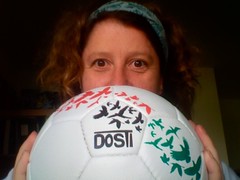 Following up on the post from yesterday regarding why nonprofits, NGOs and other mission-based organizations shouldn’t use stock photos, let’s talk today about privacy issues with photos of volunteers, particularly children.
Following up on the post from yesterday regarding why nonprofits, NGOs and other mission-based organizations shouldn’t use stock photos, let’s talk today about privacy issues with photos of volunteers, particularly children.
Back in 2010 on UKVPMs, a discussion group for volunteer managers in the United Kingdom, someone wrote:
I have vague memories of this issue being discussed before, but I’m looking into guidance (mainly for volunteers, but also for paid staff and service users) around people posting photo’s or video clips etc on You Tube and similar sites. If working with children and/or other vulnerable groups, are there clear legal responsibilities we need to be aware of ? I don’t have a deal of experience in this area, so don’t know how much vetting the sites carry out themselves and how reliable this might be. Is data protection an issue
Video and photo-sharing sites do NOT vet any photos or videos submitted to their sites, just as the phone company isn’t responsible for what you are saying in a phone conversation.
It’s important to remember that, in most countries, you cannot legally control what people take photos of or film at a public event. Think of it as the picnic in the public park rule — you cannot control someone taking photos or film of you if you are having a picnic in a public park, regardless of whether or not kids are present.
That said, you should ask your staff and volunteers (same rule for all) to adhere to certain rules regarding taking photos or filming at any of your organization’s activities, public or not, and to adhere to certain rules regarding what they do with that film and video. You need to determine what those rules should be. You need to let volunteers know this includes whatever they do with their cell phones (so no one can say — “Oh, I thought you just meant cameras“).
Do all of your staff and volunteers already sign photo release forms, saying that photos may be taken of them at organization activities in which they participate and may be used in your own outreach activities (your web site, your blog, brochures, slide show presentations, posters, etc.)? Do parents of all children participating in your programs sign such a form? If not, you definitely should get busy getting such a form put together and signed by everyone now, and everyone who joins later. You can find lots of examples of photo release forms on Google.
I don’t know how much these releases would count in a court, but they do create awareness among participants that photos are sometimes taken. I haven’t lost any volunteers over the signing of such a policy — has anyone else? (I’d be interested to hear how you handled such in the comments section below — or did you lose the volunteer altogether?).
Do you already have a policy regarding how your organization identifies children in photos? (first name only, no names at all, etc.) Make sure all staff and volunteers know this policy. If you don’t have such a policy, again, look on Google — lots of organization’s share their policy. Some I found:
With the photo release and children-in-photos policies taken care of, talk with staff and volunteers and involve them in the development of further policies regarding taking photos and film during organization activities, and how they use these photos and videos. Reinforce your confidentiality policies and children-identification-in-photos policy during these conversations. Be clear about what cannot be filmed or posted under any circumstances (personnel discussions, staff meetings, counseling sessions, etc.). I find that involving people in the conversation about policy development (asking for their feedback in my online discussion group for volunteers, at onsite meetings, informally when we meet, etc.) better guarantees people will embrace it and make sure it is enforced.
If you are going to prohibit all such photo and video-taking, you need to have very clear reasons why (in writing and in conversations), and you need to talk about what the consequences will be to staff and volunteers if the prohibition is violated. You also need to consider the consequences of such a draconian ban — you will be losing out on a significant public outreach tool. Volunteers can create a LOT of interest among their friends, family and associates for your organization when they share photos and videos of their activities as a volunteer. Also, you will probably lose more volunteers over such a draconian ban than you will if you allow photos to be taken.
One of the guidelines I have is to ask staff and volunteers to always announce to their colleagues “I’m taking photos/video now!” before they start doing so, and to respect the wishes of people who say they do not want to be filmed. Ask staff and volunteers to respect the wishes of their fellow volunteers who may contact them and ask that an image that features them on their own Flickr account (or other photo-sharing site) or YouTube account to be removed (note that these accounts are owned by them, not you). Ask staff and volunteers to share links to videos and photos with the organization, as a courtesy. Talk with volunteers about what a photo dispute might look like and how such could be negotiated/mediated (you could give them two or three fictional scenarios for discussion). And, as noted above, ask for their own suggestions for policies.
For whatever you come up with in terms of guidelines, you will have to reinforce the message frequently — you can’t just deliver the message once and expect it to be heard.
Related blogs and sites:
Social media policies for mission-based organizations
Forget the stock photos; make your own photo archive
Photos of me at work
Tags: photos, communications, communicating, mission, outreach, story, news, volunteering, volunteers, community, engagement, volunteerism, smartphones, PDAs, camera, phone, cell




 Kudos to the
Kudos to the 
